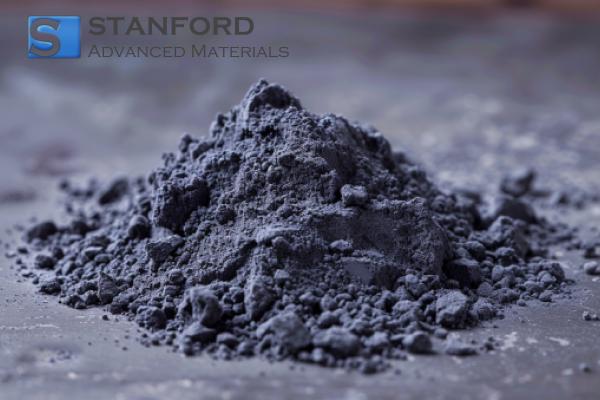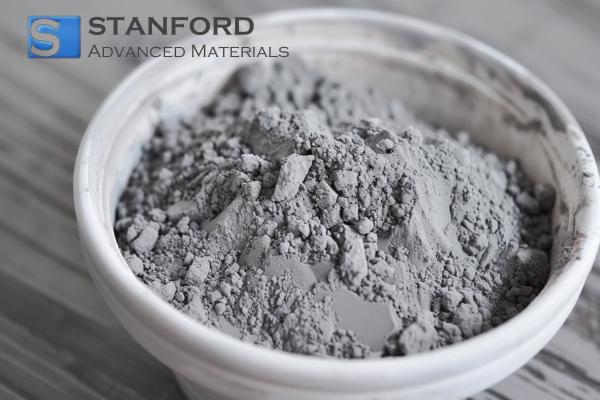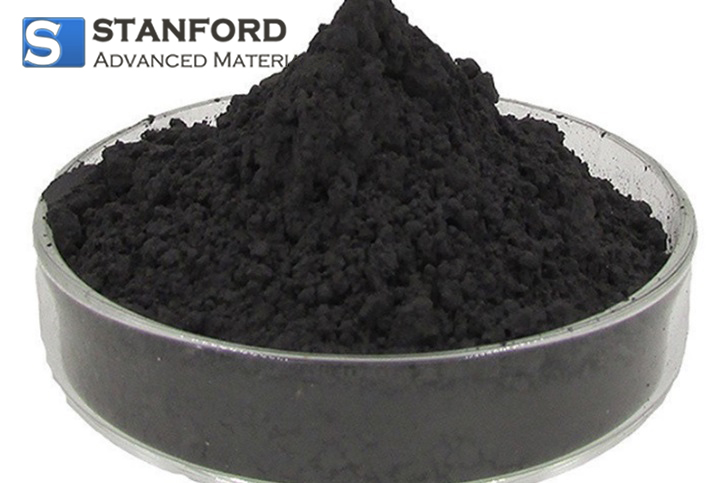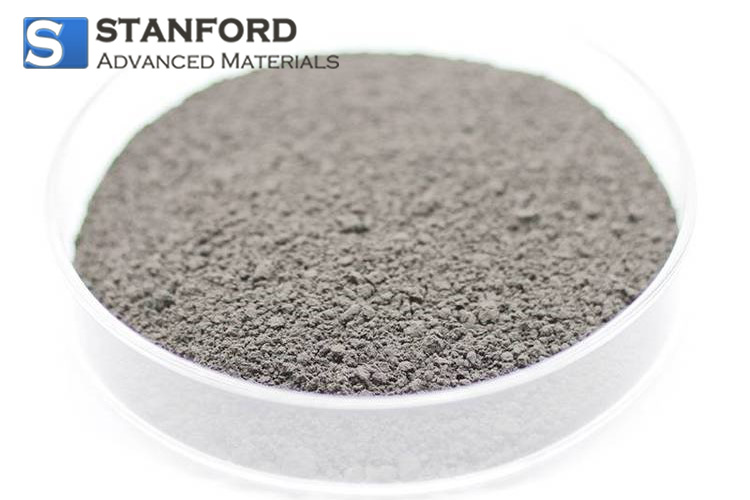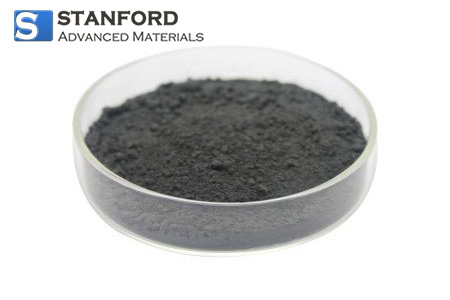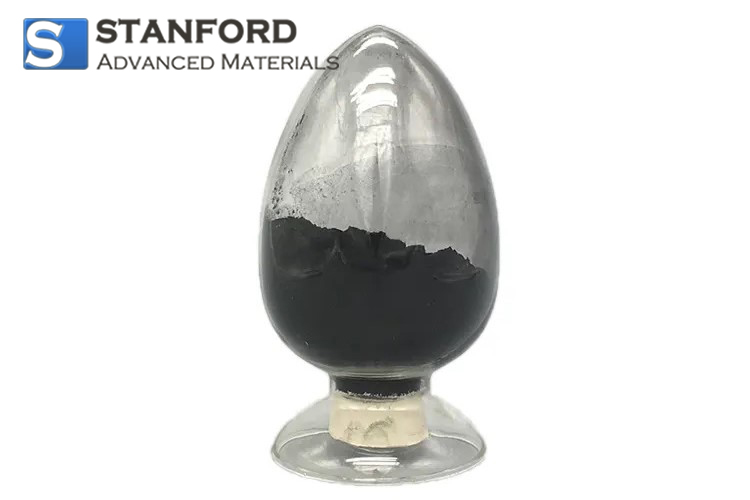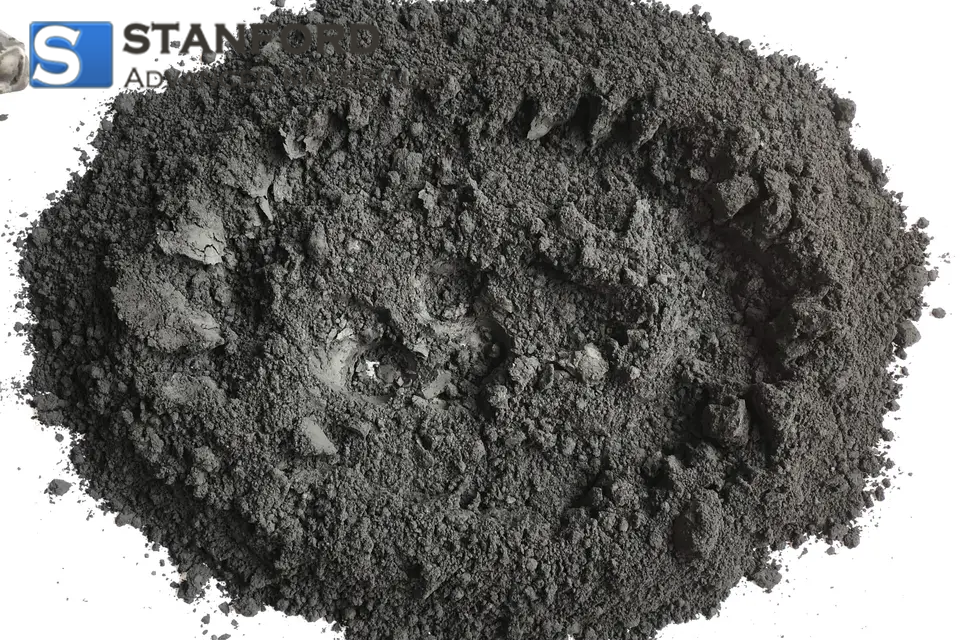SECTION 1. IDENTIFICATION
Product Name: Nickel Coated Graphite
CAS #: 7782-42-5
Relevant identified uses of the substance: Scientific research and development
Supplier details:
Stanford Advanced Materials
E-mail: sales@samaterials.com
Tel: (949) 407-8904
Address: 23661 Birtcher Dr., Lake Forest, CA 92630 U.S.A.
SECTION 2. HAZARDS IDENTIFICATION
Classification of the substance or mixture in accordance with 29 CFR 1910 (OSHA HCS)
GHS02 Flame
Flam. Sol. 2 H228 Flammable solid.
GHS08 Health hazard
Carc. 2
H351 Suspected of causing cancer.
STOT RE 1 H372 Causes damage to the lung, the kidneys and the liver through prolonged or
repeated exposure. Route of exposure: Inhalative.
GHS07
Eye Irrit. 2A H319 Causes serious eye irritation.
Skin Sens. 1 H317 May cause an allergic skin reaction.
STOT SE 3 H335 May cause respiratory irritation.
Hazards not otherwise classified
No information known.
Label elements
GHS label elements
The product is classified and labeled in accordance with 29 CFR 1910 (OSHA HCS)
Hazard pictograms
GHS02 GHS07 GHS08
Signal word
Danger
Hazard-determining components of labeling:
Nickel
Hazard statements
H228 Flammable solid.
H319 Causes serious
eye irritation.
H317 May cause an allergic skin reaction.
H351 Suspected of causing cancer.
H335 May cause respiratory irritation.
H372 Causes damage to the lung, the kidneys and the liver through prolonged or repeated exposure.
Route of exposure: Inhalative.
Precautionary statements
P210
Keep away from heat/sparks/open flames/hot surfaces. No smoking.
P260
Do not breathe dust/fume/gas/mist/vapours/spray.
P261
Avoid breathing dust/fume/gas/mist/vapours/spray.
P305+P351+P338 IF IN EYES: Rinse c
autiously with water for several minutes. Remove contact lenses, if present and easy to do. Continue
rinsing.
P405
Store locked up.
P501
Dispose of contents/container in accordance with local/regional/
national/international regulations.
WHMIS classification
B4 - Flammable solid
D2A - Very toxic material causing other toxic effects
Classification system
HMIS ratings (scale 0-4)
(Hazardous Materials Identification System)
Health (acute effects) = 2
Flammability = 2
Physical Hazard = 1
Other hazards
Results of PBT and vPvB assessment
PBT:
Not applicable.
vPvB:
Not applicable.
SECTION 3. COMPOSITION/INFORMATION ON INGREDIENTS
Chemical characterization: Mixtures
Nickel - CAS: 7440-02-0
Carc. 2, H351; STOT RE 1, H372;Skin Sens. 1, H317
Graphite - CAS: 7782-42-5
Flam. Sol. 2, H228;
Eye Irrit. 2A, H319; STOT SE 3, H335
SECTION 4. FIRST AID MEASURES
Description of first aid measures
After inhalation
Supply fresh air. If required, provide artificial respiration. Keep patient warm.
Seek immediate medical advice.
After skin contact
Immediately wash with water and soap and rinse thoroughly.
Seek immediate medical advice.
After eye contact
Rinse opened eye for several minutes under running water. Then consult a doctor.
After swallowing
Seek medical treatment.
Information for doctor
Most important symptoms and effects, both acute and delayed
No further relevant information available.
Indication of any immediate medical attention and special treatment needed
No further relevant information available.
SECTION 5. FIREFIGHTING MEASURES
Extinguishing media
Suitable extinguishing agents
Special powder for metal fires. Do not use water.
For safety reasons unsuitable extinguishing agents
Water
Special hazards arising from the substance or mixture
If this product is involved in a fire, the following can be released:
Carbon monoxide and carbon dioxide
Toxic metal oxide fume
Advice for firefighters
Protective equipment:
Wear self-contained respirator.
Wear fully protective impervious suit.
SECTION 6. ACCIDENTAL RELEASE MEASURES
Personal precautions, protective equipment and emergency procedures
Wear protective equipment. Keep unprotected persons away.
Ensure adequate ventilation
Keep away from ignition sources
Environmental precautions:
Do not allow material to be released to the environment without proper governmental permits.
Methods and material for containment and cleaning up:
Keep away from ignition sources.Dispose of contaminated material as waste according to section 13.
Ensure adequate ventilation.
Prevention of secondary hazards:
Keep away from ignition sources.
Reference to other sections
See Section 7 for information on safe handling
See Section 8 for information on personal protection equipment.
See Section 13 for disposal information.
SECTION 7. HANDLING AND STORAGE
Handling
Precautions for safe handling
Keep container tightly sealed.
Store in cool, dry place in tightly closed containers.
Ensure good ventilation at the workplace.
Information about protection against explosions and fires:
Protect against electrostatic charges.
Conditions for safe storage, including any incompatibilities
Storage
Requirements to be met by storerooms and receptacles:
Store in a cool location.
Information about storage in one common storage facility:
Store away from oxidizing agents.
Further information about storage conditions:
Keep container tightly sealed.
Store in cool, dry conditions
in well sealed containers.
Specific end use(s)
No further relevant information available.
SECTION 8. EXPOSURE CONTROLS/PERSONAL PROTECTION
Additional information about design of technical systems:
Properly operating chemical fume hood designed for hazardous chemicals and having an average
face velocity of at least 100 feet per minute.
Control parameters
Components with limit values that require monitoring at the workplace:
7440-02-0 Nickel
PEL (USA) Long-term value: 1 mg/m³
REL (USA) Long-term value: 0.015 mg/m³
as Ni; See Pocket Guide App. A
TLV (USA) Long-term value: 1.5* mg/m³
elemental, *inhalable fraction
EL (Canada) Long-term value: 0.05 mg/m³
as Ni; ACIGH A1, IARC 1
EV (Canada) Long-term value: 1* 0.2** 0.1*** mg/m³
inh.;*metal;**insol. compds.;***soluble compds.
7782-42-5 Graphite
PEL (USA) Long-term value: 15 mppcf* mg/m³
*impinger samples counted by light field techn.REL (USA) Long-term value: 2.5* mg/m³
*respirable dust
TLV (USA) Long-term value: 2* mg/m³
all forms except graphite fibers;*resp. fraction
EL (Canada) Long-term value: 2 mg/m³
EV (Canada) Long-term value: 2 mg/m³
respirable
Additional information:
No data
Exposure controls
Personal protective equipment
General protective and hygienic measures
The usual precautionary measures for handling chemicals should be followed.
Keep away from foodstuffs, beverages and feed.
Remove all soiled and contaminated clothing immediately.
Wash hands before breaks and at the end of work.
Avoid contact with the eyes.
Avoid contact with the eyes and skin.
Maintain an ergonomically appropriate working environment.
Breathing equipment:
Use suitable respirator when high concentrations are present.
Protection of hands:
Impervious gloves
Check protective gloves prior to each use for their proper condition.
The selection of suitable gloves not only depends on the material, but also on quality. Quality will vary
from manufacturer to manufacturer.
Penetration time of glove material (in minutes)
Not determined
Eye protection:
Safety glasses
Body protection:
Protective work clothing.
SECTION 9. PHYSICAL AND CHEMICAL PROPERTIES
Information on basic physical and chemical properties
General Information
Appearance:
Form: Powder
Color: Black
Odor: Odorless
Odor threshold: Not determined.
pH-value: Not applicable.
Change in condition
Melting point/Melting range: Not determined
Boiling point/Boiling range: Not determined
Sublimation temperature / start: Not determined
Flammability (solid, gaseous)
Highly flammable.
Ignition temperature: Not determined
Decomposition temperature: Not determined
Auto igniting: Product is not selfigniting.
Danger of explosion: Not determined.Explosion limits:
Lower: Not determined
Upper: Not determined
Vapor pressure: Not applicable.
Density: Not determined
Relative density: Not determined.
Vapor density: Not applicable.
Evaporation rate: Not applicable.
Solubility in / Miscibility with
Water: Insoluble
Partition coefficient (n-octanol/water): Not determined.
Viscosity:
dynamic: Not applicable.
kinematic: Not applicable.
Other information
No further relevant information available.
SECTION 10. STABILITY AND REACTIVITY
Reactivity
No information known.
Chemical stability
Stable under recommended storage conditions.
Thermal decomposition / conditions to be avoided:
Decomposition will not occur if used and stored according to specifications.
Possibility of hazardous reactions
Reacts with strong oxidizing agents
Conditions to avoid
No further relevant information available.
Incompatible materials:
Oxidizing agents
Hazardous decomposition products:
Carbon monoxide and carbon dioxide
Toxic metal oxide fume
SECTION 11. TOXICOLOGICAL INFORMATION
Information on toxicological effects
Acute toxicity:
The Registry of Toxic Effects of Chemical Substances (RTECS) contains acute toxicity data fo
r components in this product.
LD/LC50 values that are relevant for classification:
No data
Skin irritation or corrosion: May cause irritation
Eye irritation or corrosion: Causes serious eye irritation.
Sensitization: May cause an allergic skin reaction.
Germ cell mutagenicity: The Registry of Toxic Effects of Chemical Substances (RTECS)
contains mutation data for components in this product.
Carcinogenicity: Suspected of causing cancer.
IARC-2B: Possibly carcinogenic to humans: limited evidence in humans in the absence of sufficient
evidence in experimental animals.ACGIH A1: Confirmed human carcinogen: Agent is carcinogenic to humans based on epidemiologic
studies of, or convincing clinical evidence in, exposed humans.
NTP-K: Known to be carcinogenic: sufficient evidence from human studies.
The Registry of Toxic Effects of Chemical Substances (RTECS) contains tumorigenic and/or
carcinogenic and/or neoplastic data for components in this product.
Reproductive toxicity:
The Registry of Toxic Effects of Chemical Substances (RTECS) contains reproductive data for
components in this product.
Specific target organ system toxicity - repeated exposure:
Causes damage to organs through prolonged or repeated exposure.
Specific target organ system toxicity - single exposure:
May cause respiratory irritation.
Aspiration hazard:
No effects known.
Subacute to chronic toxicity:
No effects known.
Additional toxicological information:
To the best of our knowledge the acute and chronic toxicity of this subst
ance is not fully known.
The product shows the following dangers according to internally approved calculation methods for
preparations:
Irritant
SECTION 12. ECOLOGICAL INFORMATION
Toxicity
Aquatic toxicity:
No further relevant information available.
Persistence and degradability
No further relevant information available.
Bioaccumulative potential
No further relevant information available.
Mobility in soil
No further relevant information available.
Ecotoxical effects:
Remark:
Harmful to aquatic organisms
Additional ecological information:
General notes:
Do not allow product to reach ground water, water course or sewage system.
Do not allow material to be released to the environment without proper governmental permits.
Danger to drinking water if even small quantities leak into the ground.
May cause long lasting harmful effects to aquatic life.
Avoid transfer into the environment.
Harmful to aquatic organisms
Results of PBT and vPvB assessment
PBT: Not applicable.
vPvB: Not applicable.
Other adverse effects
No further relevant information available.
SECTION 13. DISPOSAL CONSIDERATIONS
Waste treatment methods
Recommendation
Consult state, local or national regulations to ensure proper disposal.
Uncleaned packagings:
Recommendation:
Disposal must be made according to official regulations
SECTION 14. TRANSPORT INFORMATION
UN-Number
DOT, IMDG, IATA
UN3178
UN proper shipping name
DOT
Flammable solid, inorganic, N.O.S. (graphite, nickel powder)
IMDG, IATA
FLAMMABLE SOLID, INORGANIC, N.O.S. (graphite, nickel powder)
Transport hazard class(es)
DOT
Class
4.1 Flammable solids, self-reactive substances and solid desensitised explosives.
Label
4.1
Class
4.1 (F3) Flammable solids, self-reactive substances and solid desensitised explosives
Label
4.1
IMDG, IATA
Class
4.1 Flammable solids, self-reactive substances and solid desensitised explosives.
Label
4.1
Packing group
DOT, IMDG, IATA
III
Environmental hazards:
Not applicable.
Special precautions for user
Warning: Flammable solids, self-reactive substances and solid desensitised explosives
Transport in bulk according to Annex II of MARPOL73/78 and the IBC Code
Not applicable.
Transport/Additional information:
DOT
Marine Pollutant (DOT): No
UN "Model Regulation":
UN3178, Flammable solid, inorganic, n.o.s. (graphite, Nickel powder), 4.1, III
SECTION 15. REGULATORY INFORMATION
Safety, health and environmental regulations/legislation specific for the substance or mixtureGHS label elements
The product is classified and labeled in accordance with 29 CFR 1910 (OSHA HCS)
Signal word
Danger
Hazard-determining components of labeling:
Nickel
Hazard statements
H228 Flammable solid.
H319 Causes serious eye irritation.
H317 May cause an allergic skin reaction.
H351 Suspected of causing cancer.
H335 May cause respiratory irritation.
H372 Causes damage to the lung, the kidneys and the liver through prolonged or repeated exposure.
Route of exposure: Inhalative.
Precautionary statements
P210 Keep away from heat/sparks/open flames/hot surfaces. No smoking.
P260 Do not breathe dust/fume/gas/mist/vapours/spray.
P261 Avoid breathing dust/fume/gas/mist/vapours/spray.
P305+P351+P338 IF IN EYES: Rinse cautiously with water for several minutes. Remove contact
lenses, if present and easy to do. Continue rinsing.
P405 Store locked up.
P501 Dispose of contents/container in accordance with local/regional/national/international
regulations.
National regulations
All components of this product are listed in the U.S. Environmental Protection Agency Toxic
Substances Control Act Chemical substance Inventory.
All components of this product are listed on the Canadian Domestic Substances List (DSL).
SARA Section 313 (specific toxic chemical listings)
7440-02-0 Nickel
California Proposition 65
Prop 65 - Chemicals known to cause cancer
7440-02-0 Nickel
Prop 65 - Developmental toxicity
None of the ingredients are listed.
Prop 65 - Developmental toxicity, female
None of the ingredients are listed.
Prop 65 - Developmental toxicity, male
None of the ingredients are listed.
Information about limitation of use:
For use only by technically qualified individuals.
This product is subject to the reporting requirements of section 313 of the Emergency Planning and
Community Right to Know Act of 1986 and 40CFR372.
Other regulations, limitations and prohibitive regulations
Substance of Very High Concern (SVHC) according to the REACH Regulations (EC) No. 1907/2006.
None of the ingredients are listed.
The conditions of restrictions according to Article 67 and Annex XVII of the Regulation (EC) No
1907/2006 (REACH) for the manufacturing, placing on themarket and use must be observed.
None of the ingredients is listed.
Annex XIV of the REACH Regulations (requiring Authorisation for use)
None of the ingredients is listed.
Chemical safety assessment:
A Chemical Safety Assessment has not been carried out.
SECTION 16. OTHER INFORMATION
Safety Data Sheet according to Regulation (EC) No. 1907/2006 (REACH). The above information is
believed to be correct but does not purport to be all inclusive and shall be used only as a guide. The
information in this document is based on the present state of our knowledge and is applicable to the
product with regard to appropriate safety precautions. It does not represent any guarantee of the
properties of the product.

